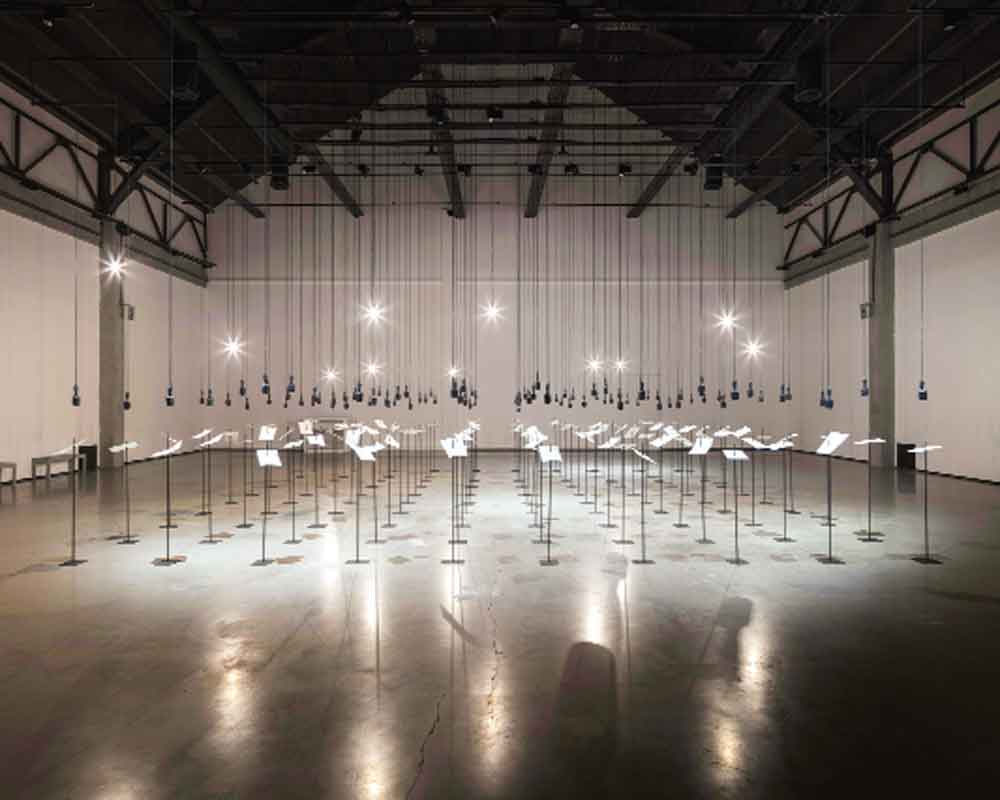Ralph Rugoff’s choice of three Indian artists speaks of his acumen, his observation and his erudite understanding of knowing that his role is one of great responsibility and deep understanding.By Uma Nair
For his group show, May You live Interesting Times, at the Venice Biennale, curator Ralph Rugoff’s has chosen three Indian artists from 79. The choice speaks of his acumen, his observation and his erudite understanding of knowing that his role is one of great responsibility and deep understanding.
Amongst the three are Shilpa Gupta who has a penchant for reinventing herself with each installation, Gauri Gill who has spent years blending the verbal and visual in research tenets of marginalised communities in far-flung places such as Maharashtra and Rajasthan and the youngest of the lot, 30-year-old nocturne hunter, Soham Gupta who walks into the other side of midnight in Kolkata to find his subjects unravel an angst that we have never cared to observe.
Rugoff’s title
When we look at the three artists, we are aware that he has picked them for the prowess in creating commentaries on the power and pathos found in communities, both past and present. When asked why he chose his title he has stated, “I also wanted a title that wasn’t too specific, but framed the times we live in. This Biennale responds to this moment in time and that is what is interesting about such events. They give you a form to think again about what happened in the last two years and what new ideas are changing the future that we are moving towards. What I was really interested in, was artists whose work is very open-ended and is more about asking questions than providing answers and experiments with the way we look at images and think about stories. A lot of this came from the ideas of Umberto Eco’s 1962 piece, The Open Work, where he gives a perfect description of what the culture of contemporary art has been for the last 60 years and continues to be and why it has value for society.”
Soham Gupta’s Kolkata
Soham’s Angst, a poignant series of portraits, entirely shot at night, portrays people in Kolkata who live on the margins of society. In an interview he states, “ I have been working on Angst since 2013. It is a work in progress. It has now evolved into a hopeless tale of a fictive night-time hellhole, whose nooks and crannies are inhabited by decaying souls. It has its roots in my childhood riddled with severe asthma attacks and in my troubled growing-up years spent trying to come to terms with the world’s expectations. I want this work to ultimately stand as testimony to the requiem of countless dreams, even as it is a record of my angst-ridden youth.”
Shilpa Gupta 100 poets and Gateway
Shilpa Gupta creates history of sorts for having two immersive installations in the Venice Biennale. Rugoff obviously understood her brilliance and her ability to reinvent the vitality of research and installation to present a comment on society. Shilpa Gupta’s new multi-channel sound installation gives voice to 100 poets who have been jailed through time for their writing or their beliefs. On entering the dimly-lit space of the Fire Station, visitors will encounter 100 microphones suspended over 100 metal rods, each piercing a verse of poetry. Over the course of an hour, each microphone in turn recites a fragment of the poets’ words, spoken first by a single voice then echoed by a chorus which shifts across space.
The poets’ words emerge from microphones, fitted with speakers, a device Gupta has adopted in earlier works to remind us that the microphone is not simply something to speak into, but a means to broadcast a message on a large scale. Here the microphones literally and symbolically give a voice to those whom regimes from around the world have sought to silence.
The idea of creating an archive of 100 emblematic instances is an approach the artist has adopted in previous works as well. Someone else: a library of 100 books published anonymously or under pseudonyms (2011), had brought together 100 books published by an author under another name as the author wanted to remain anonymous. Each one was etched in metal.
Shilpa’s second installation is a gate that swings back and forth as it hits and breaks the wall that it is embedded in.
Gauri Gill
Gauri Gill, India’s archival photographer who has been creating stunning narratives of groups of people in marginalised peripheries, unveils two important series of works.The first Acts of Appearance was shown at the Met museum last year. It is a series of vivid colour photographs for which the artist worked closely with members of an Adivasi community in Jawhar district of Maharashtra. Gill’s collaborator-subjects are renowned for their paper-mâché objects, including traditional sacred masks. In these pictures they engage in everyday village activities while wearing new masks, made expressly for this body of work, which depict living beings with the physical characteristics of humans, animals, or valued objects. A range of scenarios and narratives, situated in both “reality” and dreamlike state, come together in the photographs, which simultaneously portray symbolic or playful representations as well as the familiar experiences of community members against the backdrop of their home and culture.
Gill’s second set of works is entitled Becoming 2003 and deals with a study of narratives that envision a documentation of the tapestry of time.
In choosing all three Indian contemporary artists Rugoff presents the finest in the search for societal commentaries that talk about universal truths and the widening of gaps between the richest and the poorest.
(The Venice Biennale runs till November 2019.)
Writer: Uma Nair
Courtesy: The Pioneer








 OpinionExpress.In
OpinionExpress.In















Comments (0)